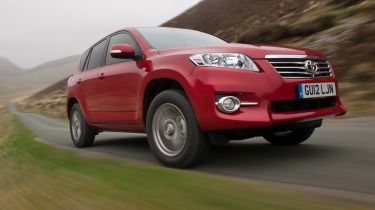Toyota RAV4 (2006-2013) review
The Toyota RAV4 invented the compact SUV class, and it's still a reliable, efficient and practical choice

The current Toyota RAV4 has a tough battle in the compact SUV market. Alongside rivals like the Land Rover Freelander, Honda CR-V and Nissan X-Trail it all but fades into the background. It is by no means a bad car – it is competent, if uninspiring to drive, and the styling is universally inoffensive – but it struggles to tick as many boxes as its rivals. Practicality is down on the Freelander, it isn’t as car-like to drive as the X-Trail and it doesn’t look as radical as a CR-V. But if you want a thoroughly dependable, mid-sized-SUV then the RAV4, with Toyota’s generous five-year warranty, represents a sensible choice.
Engines, performance and drive
The RAV4 is capable rather than exciting. It feels safe and secure on the road and remains comfortable and composed through the bends. The clever four-wheel-drive system works well, constantly assessing traction and sending power to the wheels that need it most. The steering is light but accurate, which inspires confidence and comes in handy when parking. The soft suspension does a good job, too, managing not to wallow or roll too much when the RAV4 is pushed. There is a 2.0-litre petrol motor, but it’s best avoided as it is both thirstier and slower than the 2.2-litre D-4D diesel powerplant – which manages 0-62mph in a respectable 10.2 seconds.
MPG, CO2 and Running Costs
If you opt for the pick of the RAV4 range – the 2.2 D-4D diesel – then you’ll be pleasantly surprised by the quoted economy. It manages 47.1mpg, which is an identical figure to the two-wheel-drive only version with the same engine. In comparison, the Honda CR-V manages just 43.5mpg. A positive for the RAV4 is the five-year warranty that the manufacturer now offers on all new cars, which should give some peace of mind to prospective owners. Kit levels are good too, with even base-spec models getting an MP3-compatible stereo, air-con and alloys as standard.
Interior, design and technology
The original Toyota RAV4 was a trendsetter back in the mid-nineties, but with time the innovative styling has sobered up. The current model lacks the sportiness of the car it replaces. Alongside the curvaceous Honda CR-V it looks uninspiring, and next to the chunky Nissan X-Trail it appears soft and unexciting. The side-hinged tailgate feels dated and impractical – even Land Rover has now ditched it in favour of a roof-hinged door. However, the inside fares much better, with a quality dash and upmarket materials. The layout is good, with contrasting plastics surrounding the central display – what the Toyota lacks on the outside, it makes up for behind the wheel.
Practicality, comfort and boot space
Space in the back of the Toyota RAV4 is good, and the 60:40 split seats slide back and forth, meaning the layout can be altered in favour of legroom or boot space. When folded, the seats totally disappear, revealing a usefully flat load area – only hindered by the side-hinged door which limits practicality in tight spaces – Toyota would be better off using a roof-hinged design. Parking sensors, cruise control and Bluetooth come as standard on most trim levels, meaning you can realistically buy a RAV4 without adding lots of expensive extras – something that can’t be said of the Land Rover Freelander.
Reliability and Safety
The RAV4 comes with a host of airbags; some models even get protection for the driver and passenger’s knees. The steering is sharp and direct, meaning the car feels stable unless properly pushed which inspires confidence for those behind the wheel. In terms of safety, the ageing Toyota only manages four stars in the Euro NCAP crash tests – where the accomplished Land Rover Freelander scores top marks. Toyota performs consistently well in terms of reliability, and placed fifth in the 2012 Driver Power survey – with the MkII RAV4 coming 28th in model classifications – proving owners are a satisfied bunch.








